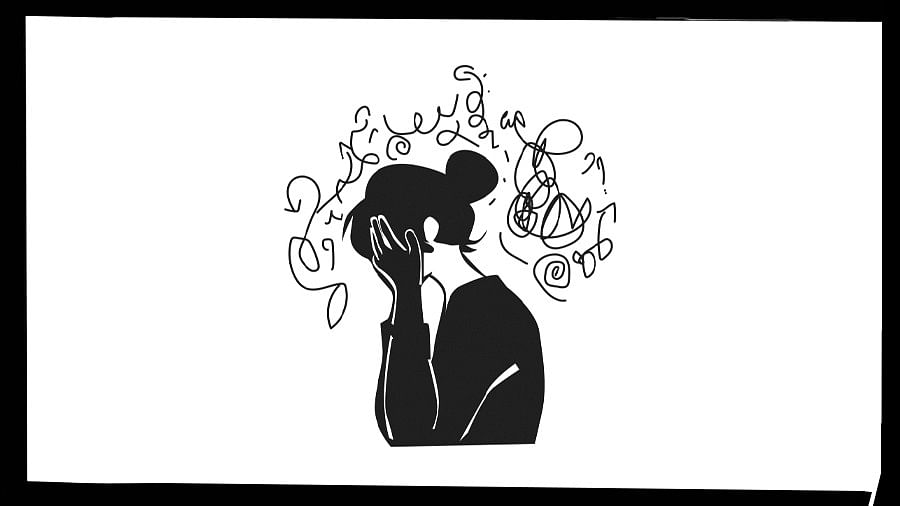
Credit: DH illustration
She was in a daze, appeared confused and kept wringing her hands. Radha was admitted in our mother-baby inpatient unit because she had tried to end her life, but more importantly, her husband had found their two-month-old baby limp and lifeless near her. Gradually, Radha would tell us how she became depressed after the birth of her baby and started fearing for her own life and that of her baby. “I felt terrified and I did not want my baby to come to any harm, I was convinced someone would hurt her. I knew she couldn’t live if I was not there.”
Even after 35 years of working as a psychiatrist and specialising in the care of mothers with young children, filicide – the act of a parent killing his/her own child -- never fails to cause me dismay and sadness, both for the parent and the child. Not surprisingly, filicide has been described as the “most emotive of all offences”.
A mother killing her child goes against our notions of a loving, unconditional, kind and compassionate figure who will go to any lengths to protect her child from harm. Stories like the Judgement of Solomon or from the Jataka Tales where a mother would even gladly give up any claim to her child to protect it from harm, perpetuate this image. So, when a woman is suspected of killing her child, like in the recent incident of Suchana Seth, society is shocked and horrified because it goes against everything one knows about maternal love.
It is true that violent crimes, especially homicide, are infrequently perpetrated by women, except for filicide. In fact, data shows that the rate of female perpetrators is higher in filicide in comparison to the proportion of women committing other forms of homicide.
What are the situations where a mother may kill her child?
The commonest one is called altruistic suicide, where a woman believes that if the child survives, it will suffer. The filicide is done in the “child’s best interest”, often happening when a woman is in very difficult circumstances. Nearly 30% of mothers who kill their children also end their lives by suicide or try to end their lives.
I was asked a few years ago by a forensic psychiatrist in a European country to read letters written by an Indian nurse who had recently migrated to that country. She had thrown her five-year-old daughter from a sixth-floor balcony. We wanted to understand through her letters the mental state that she was in and the cultural and migration-related issues that might have prompted her to take this drastic step. It was clear from the letters to her family in India that her anxiety related to the child’s wellbeing was escalating. She would soon have to send her child back to India and had been worrying excessively about the child being abused. One day, not able
to handle her own anxiety and paranoia, she decided to “protect” her child
from potential sexual abuse by ending the child’s life.
One of the other situations where a child may die at the hands of a mother may be an accidental death related to child maltreatment. For example, a mother may hit a child without any intention of killing the child, but the child may fall or sustain a severe injury and die.
Another important finding in many countries has been a rising number in filicides related to divorce, severe parental conflict, and custody disputes. Some experts in the field also use the term ‘Revenge Filicide’, which is related to severe relationship problems with a partner or spouse. Here, the child is killed as revenge against the spouse’s behaviour, infidelity, divorce, and especially custody and visitation disputes.
Clearly, a mother who kills her child must be held accountable for the action. However, it is important to also understand the mental state of the mother prior to the incident, any earlier history of mental illness, criminal behaviour, child maltreatment or violence.
The role of violence and trauma
Women who commit filicide have been found to have high rates of childhood trauma and violent victimisation that persists into adulthood. While a majority of filicidal mothers do not have a criminal history, they have reported powerlessness, helplessness and social isolation prior to the offence. Especially in situations where there is separation or divorce, while the woman may escape a violent relationship, she may lose social supports and become more isolated, which may cause severe stress. Fathers who kill their own child usually have a history of previous violence or criminal behaviour, but this is usually not the case with mothers who commit filicide.
What can society do to prevent filicide?
Families, schools, and communities must pay more attention to children who are in families where there is parental discord, separation or divorce. Supporting parents and providing safe spaces for them to discuss their concerns and distress is necessary to interrupt the pathway of victims of violence to becoming perpetrators themselves. Women with mental illness with infants and toddlers should be identified early and the
risk of suicide and infanticide highlighted to the family.
We should remember that filicides are preventable if family, community and health, as well as legal, systems are vigilant and keep a child’s welfare at
the centre.
(The writer is Senior Professor of Psychiatry and Dean, NIMHANS, Bengaluru)